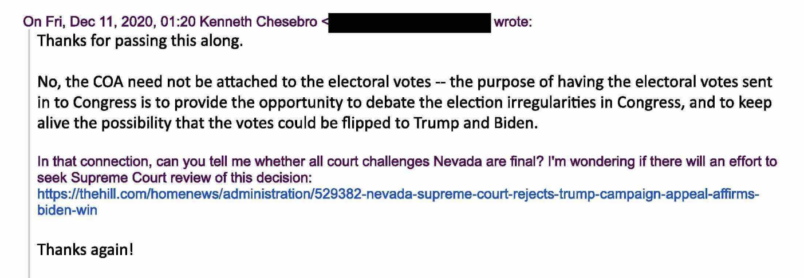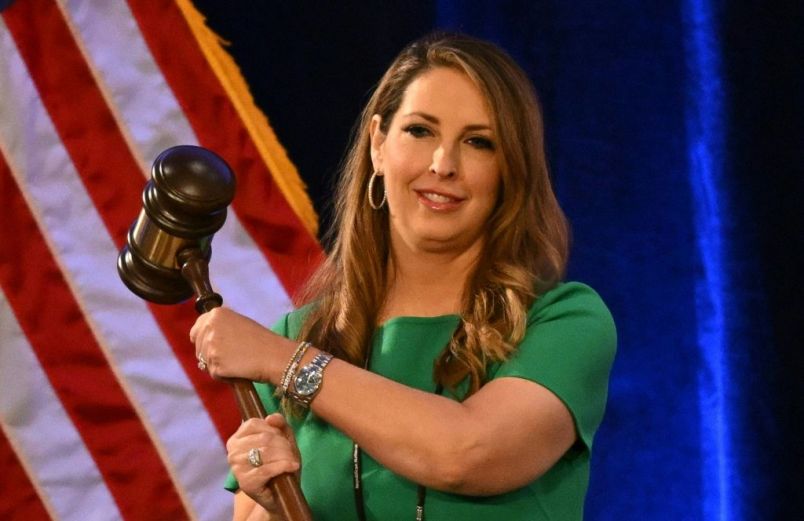Faced with loss in the 2020 election, Trump campaign attorneys built an elaborate mind palace in which the former president could steal victory from the jaws of defeat.
The problem was, building that universe required persuading real people to lie — not in the imaginary world where Trump reversed his loss, but in the actual world where lying has consequences.
Emails first released by the Jan. 6 Committee that have not previously been reported on in detail reveal how several key Trump attorneys coordinated the actions of two fake electors from the state of Nevada — both of whom have now reportedly received immunity in exchange for testimony in Special Counsel Jack Smith’s investigation.
The emails show Trump attorney Kenneth Chesebro directing would-be fake electors Jim DeGraffenreid and Michael McDonald how to become fake electors — a topic now at the center of Smith’s review of Trump’s effort to reverse the 2020 election. Private messages, also released by the committee, show that McDonald, DeGraffenreid, and other Nevada fake electors were eager to participate in what Chesebro described to them as an effort to “keep alive the possibility that the votes could be flipped to Trump and Biden.”

But the messages also show that the electors were aware, and at times concerned, about the potential legal issues at play. In one message that DeGraffenreid sent to another fake elector the day before they cast their ballots on Dec. 14 the two discussed the procedures needed under state law to cast the electoral votes, with DeGraffenreid writing that “facts and legalities don’t matter – only what you can burn someone with.”
The next day, the fake electors would take the first step towards what may end up being a scheme to defraud the United States via the creation of fake legal documents submitted to Congress and the National Archives. DeGraffenreid and McDonald didn’t return TPM’s requests for comment. Chesebro did not return a request for comment.
One GOP operative familiar with the fake electors effort told TPM that the electors themselves had been misled.
“These guys were innocent people just doing what folks they trusted had asked them to do,” the person said, telling TPM that senior Trump campaign officials in the state understood that The Donald had lost Nevada. “They knew they couldn’t win in Nevada.”
Legal experts and former federal prosecutors have long described the fake electors scheme as the most direct, provable crime in Trump’s attempt to reverse his 2020 loss. While filling out a document proclaiming yourself an elector for a losing candidate is not a crime, lying to the federal government — or presenting a document to federal agencies or Congress saying that you are an elector — is.
The New York Times reported on Wednesday that one of the Trump allies involved in the scheme, Rudy Giuliani, spoke with Smith’s office this week under a proffer agreement — often, but not always, the prelude to a cooperation agreement. CNN reported that Mike Roman, a Trump campaign official who delivered the fake elector ballots to Congress, is cooperating with the special counsel.
In the materials released by the January 6 Committee, the pace of messages — between DeGraffenreid, McDonald, other fake electors, RNC operatives, and Trump campaign attorneys including Chesebro — picked up on Dec. 10, 2020, as the Trump campaign organized fake electors in Nevada.
Chesebro described Nevada in a Dec. 9, 2020 memo to Wisconsin Trump attorney Jim Troupis as “extremely problematic” because that state’s laws imposed more requirements on the electors than others did.
The next day, Chesebro made his pitch to the Nevada electors themselves. Introducing himself as an attorney who was contacting them at Giuliani’s direction, Chesebro explained over a series of messages how they would become “alternate electors,” and how he would ensure that it was legal.

Chesebro attached copies of the memos that he had circulated within the Trump campaign, telling the electors that their ballots would go to Congress with two purposes in mind: to debate “election irregularities,” and to “keep alive the possibility that the votes could be flipped to Trump and Biden.” In a separate message, Chesebro sent a manual on how to cast Electoral College votes in Nevada, drafts of Nevada Electoral College ballots, a draft certificate of Trump-Pence elector votes, and a form to fill Electoral College vacancies in Nevada to a group of RNC regional political directors. That message was forwarded on to DeGraffenreid and McDonald — both of whom have now received immunity.
David Becker, executive director of the center for election innovation and research, told TPM that the ballots were bogus partly because, by Dec. 14, 2020, the courts had ruled decisively on the Trump campaign’s challenges to the election.
“By that point, we already knew who won those elections,” he said.
The messages show that Chesebro was aware of the issue, asking DeGraffenreid on Dec. 11 if he knew whether “all court challenges in Nevada are final.” DeGraffenreid forwarded the message to Jesse Binnall, another Trump campaign attorney involved in the 2020 election litigation.
While the fake electors themselves at times seem to understand that what they were involved in was legally perilous and, at other times, appear to believe that the reasoning provided by Chesebro gave them a path forward.
Later that day, DeGraffenreid forwarded Chesebro’s messages to other electors, saying that they explained the “process and the justification for our actions.”
After receiving direction from Chesebro on how to become fake electors, and discussing it among themselves, DeGrafffenreid and others acted: they cast ballots presenting themselves as Nevada’s electors. Now, they’ve reportedly received immunity to testify about the experience.
Dennis Aftergut, a former federal prosecutor and of counsel to Lawyers Defending Democracy, told TPM that the Trump attorneys could lead investigators further upwards.
“Chesebro was working very closely with [John] Eastman and certainly [Boris] Epshteyn,” he said. “They are all one short step away from Trump.”






